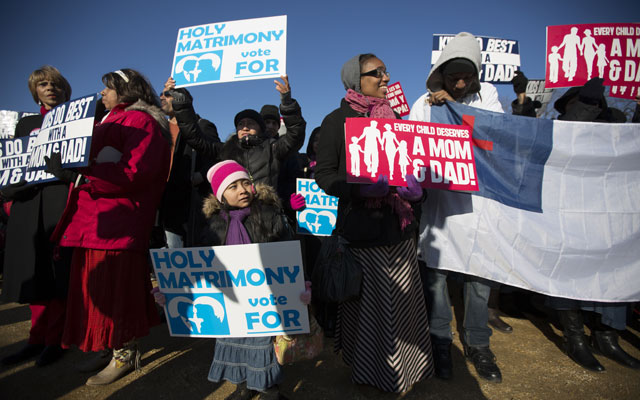This morning, the Supreme Court heard oral arguments in United States v. Windsor, a constitutional challenge to the Defense of Marriage Act (DOMA), which defined marriage as the union of a man and woman for purposes of federal benefits.
In this case, the issue was an estate tax bill faced by a partner to a same-sex relationship when she inherited from her partner. For more than a decade, Heritage has called for elimination of the estate tax, which demonstrates that addressing particular fairness concerns can be done on a policy basis without redefining marriage.
In this Heritage Legal Memorandum, law professor John Eastman writes that the Defense of Marriage Act (DOMA) was passed in 1996 to “prevent the policies of a single state from determining the policies of all the states and the federal government.” DOMA reinforced the idea that the states, as laboratories of democracy, should determine for themselves whether to recognize same-sex marriages. And, just as importantly, the federal government has the authority to determine its own definition of marriage for purposes of federal law.
During today’s argument, former Solicitor General Paul Clement (representing Members of Congress defending DOMA) explained that the federal government has various interests in defining marriage uniformly for federal law purposes and not providing an incentive for states to change their own state marriage laws.
In response to the charge that the only (or primary) animus was Congress’s motivation, Clement noted that more than 80 Senators and President Clinton supported DOMA in 1996. In fact, there are good reasons to support traditional marriage, as Heritage scholar Ryan Anderson showed on “Piers Morgan Live” last night.
As a preliminary matter, the justices must decide if a bipartisan group of Members of Congress has legal standing to defend DOMA in court. In 2011, the Obama Administration decided it would continue to enforce DOMA but would no longer defend it in court, having decided that the act is unconstitutional. Justices found the Administration’s actions “unprecedented” and “very troubling.”
The justices heard an hour of argument on this issue before proceeding to the heart of the case: Does the federal definition of marriage violate the Equal Protection Clause?
The Court reviews classifications such as one based on sexual orientation under “rational basis” review, although Solicitor General Donald Verrilli Jr. and counsel for Windsor asked the Court to apply more scrutiny. As Eastman argues, a classification based on sexual orientation easily passes rational basis review, because it furthers a legitimate governmental purpose: encouraging procreation in stable relationships. (Clement repeatedly pointed out that the federal government also has an interest in uniformity throughout the states as well.) Eastman noted that the Court has been
very reluctant to create new “suspect” or “quasi-suspect” classes entitled to heightened scrutiny, recognizing that heightened scrutiny supplants the deference that the courts normally owe to the legislative process.
Toward the end of the second hour of argument, the attorney for Windsor said there had been a sea change in attitudes regarding same-sex marriage. Chief Justice Roberts noted that this is a good indicator that there is a full and robust debate in the political sphere; as such, gays and lesbians do not lack political power to seek changes through their elected representatives (one of the things the Court looks at in deciding to apply heightened scrutiny).
Decisions in this case and the California marriage case will likely be handed down at the end of the Court’s term in June.





























